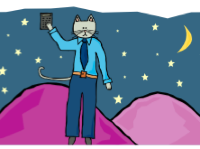 CATS: The Nine Lives of Innovation
CATS: The Nine Lives of Innovation
By Dr. Stephen C. Lundin, Ph.D (BrainReady Special Guest contributor)
I am presently on a four-week speaking tour in Australia and New Zealand and have been pondering how to put your amazing brain to work on something that has kept the world clothed, fed, housed and entertained since the time we first stood upright. That would of course be innovation. And would you believe your brain has a love-hate relationship with innovation? It's true.
CATS: The Nine Lives of Innovation, to be published in Australia this September, is the subject of talks I am about to give in Auckland, Christchurch and Wellington, New Zealand. As I prepare for these talks, I have been thinking of you, the BrainReady readers & listeners, and have decided to select a few specific topics from the material to present in the next few guest blog articles for BrainReady.
Part One: Overview
Stay with me, I need to start with a wide net. The way we write and talk about organizations often has unintended consequences. This is especially true when the subject is innovation. Our business language treats the organization as if it were alive and intelligent, making decisions and watching over us at night as we sleep; a benevolent being that has our best interests at heart. “The XYZ organization takes good care of its workers.” “The ABC Corporation is a good example of company that cares for its workers". In my early graduate school days we would have said that we "anthropomorphize" the organization.
We pretend it has human qualities.
I could argue that organizations not only don’t have human qualities, they really don’t exist at all. Have you ever seen one? Buildings yes, people ok, equipment for sure, legal documents by the kilo, but have you ever seen an organization? No. Of course not! An organization exists only as an abstraction.
So talking about an abstraction as if it were innovative, forward thinking, nimble, or customer-centric may sound great, but it does nothing to help you understand the reality and often diffuses a clear sense of responsibility. “It is the organization's fault, nothing personal you know.” To be clear in our communication and get beyond the abstraction, what we attribute to organizations we should attribute to people instead. It is individual human beings, alone or in a group, that have human qualities. Thus, innovation at its core is personal.
Saying the organization is "generous" is a shorthand for generous decisions made by specific individuals in the organization. The organization is nimble means quick decisions were made by large numbers of people. The organization is innovative is a way of saying the organization has people who are innovative. A caring organization is in fact caring people working for an abstraction called the organization.
The heart of innovation in any organization is the individual. And the individual will always encounter four basic challenges to innovation. We will discuss these challenges and highlight the brain connections. And once we have explored the challenges, we will look at the tools we have to become a CAT; or someone who can use the "nine lives of innovation" to enhance her or his personal innovation level.
So the four basic challenges that must be overcome in order to enhance the innovation quotient in a life are:
Doubts and Fears – The doubts and fears accumulated over a lifetime are there, in part, to keep us safe and secure. They can also serve as a straightjacket preventing innovation.
Normalcy – In order to survive as human beings we are endowed with the ability to be normal. This means we develop standard ways to approach life’s many challenges, from getting dressed in the morning to avoiding saber tooth tigers on the way to work. But innovation requires getting outside the norm and that is no small task given the amount of practice we give normal.
Failure – Even though failure is fundamental to learning, most of us grow up simply trying to avoid failure. No one wakes up in the morning desiring more failure but to make progress we must come to grips with the importance of failure in the learning and innovation process. To innovate we must understand and embrace failure.
Change – All innovation requires novel action and novel action is another way to say change. Change is a field of study that captures the attention of university students, scholars,
CEO’s, inventors, mothers and fathers, emplyoyees and corporate managers. Human beings have daily experiences with change. In addition, an extensive lore has developed around the subject complete with numerous metaphors for why we humans hesitate to change. This hesitation often called resistance when it could just as easily be called a life skill.
The Nine Lives of Innovation
Each of the challenges listed must be met with one or more remedies. These principle-based solutions are what we call the Nine Lives of Innovation because they have the power to support innovation by overcoming the challenges that are always present. In other words, these remedies can help innovation come alive in a world naturally full of challenges. Each of the Nine Lives is listed below and briefly described. These lives are then developed in detail in the text:
Quiet Mind – There is a constant conversation going on in most minds that must be quieted in order to find the space for innovation.
Preparation – Innovation favors a prepared mind. The way you organize your experience in the warehouses of your long-term memory can serve you well when it comes time to innovate.
Normal – One way to counter the effects of being normal is to understand how and why we humans have evolved the way we have. There is a reason for the creation called human.
Real Provocation – To escape from the clutches of what is normal we can provoke ourselves with scenarios, objects, real world observations and stimulation from guided interaction with others.
Imaginary Provocation - To escape the containing power the norm we can stimulate our thinking with mental assaults and imaginary challenges.
How Fascinating! – A great way to meet failure is with whimsy. “I invested in a start-up and lost everything. How fascinating! What can I learn from this?”
Failing Well – Fail early and fail well in order to succeed at innovation.
Tactics of Innovation and – All innovation is change. Need I say more?
Wrangling CATS – The job of the CAT Wrangler is to herd cats through a labyrinth called change. We can learn a great deal from CAT Wraglers.
Over the next few months I will be drawing from CATS those topics that have the biggest brain connection in order to show you how your brain can become a high-powered innovation machine...
Best,
- Dr. Tuna
(We'd like to thank Dr. Lundin for yet another rich, insightful, and exclusive BrainReady Blog contribution...particularly given that he's busy speaking and traveling all over Australia and New Zealand this month! Big thanks, Dr. Tuna, and we're jealous that you get to see all the wonders of Australia and New Zealand while it continues to rain here in Seattle... :)
